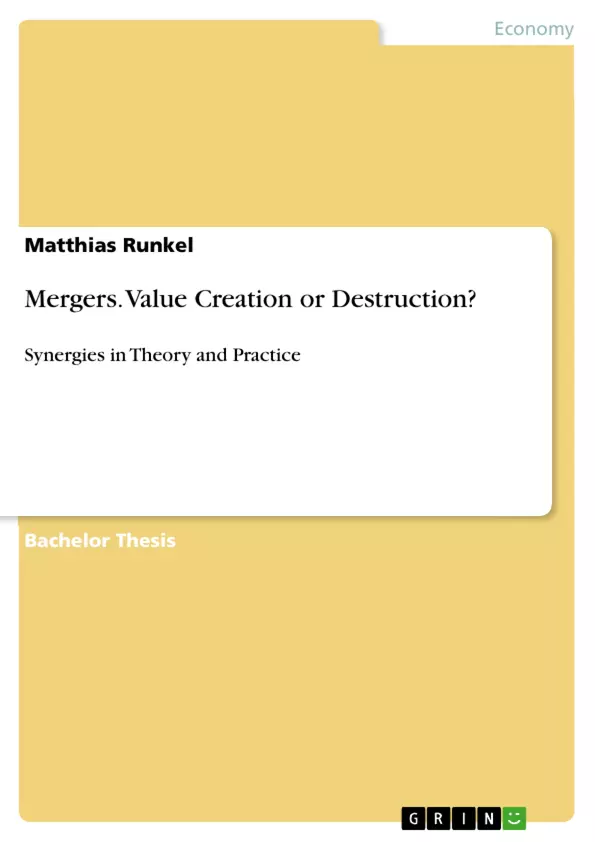Mergers and acquisition (M&A) are one of the most important topics in the business world. They provide so many news that online newspapers like the New York Times dedicate own sections to them. Some of the largest mergers did cost more than 100 billion US dollars. In consideration of this public interest and these enormous dollar amounts, a lot of research has been conducted to answer a fundamental question: Do mergers really create value?
In order to answer this question, this paper gives an overview of influential research in the wide field of M&A. It is necessary to first provide a theoretical framework to show how a merger be-tween two firms creates synergies. In other words, how can the value of two merged companies be larger than their independent sum? With this framework in mind, it is possible to look at re-sults of academic research on whether mergers create value in practice and the determinants of success and failure. Another interesting topic in the field of M&A is merger waves, periods with abnormally high merger activity. Several of such waves have been observed, but their cause and return are still topic of academic debate.
The remainder of this study is structured as follows. The next section reviews the most important reasons to merge in order to understand the theoretical value-creating potential. The third section discusses whether mergers also create value in practice and who benefits the most. Section four describes how merger success or failure depends on different properties of involved parties and deal characteristics. The fifth section gives a brief summary of the last three big merger waves and depicts how the occurrences of such waves are explained by two competing theories. The last section concludes the study.
Inhaltsverzeichnis (Table of Contents)
- Introduction
- Reasons to merge
- Financial synergies
- Operating synergies
- Management incentives
- Do mergers create value?
- Important factors for value creation
- Bidder characteristics
- Target characteristics
- Deal characteristics
- Merger Waves
- Conclusion
Zielsetzung und Themenschwerpunkte (Objectives and Key Themes)
This paper aims to investigate whether mergers create value. It first outlines the theoretical framework of mergers, emphasizing potential value-creating synergies. Then, it examines empirical research on the value-creating potential of mergers in practice and explores the determinants of merger success or failure. The study also explores the phenomena of merger waves, periods of unusually high merger activity, discussing the explanations for their occurrence and the returns they generate.
- Synergies and value creation in mergers
- Determinants of merger success and failure
- The hubris hypothesis and winner’s curse
- The impact of merger waves on corporate performance
- The role of managerial incentives and corporate governance in mergers
Zusammenfassung der Kapitel (Chapter Summaries)
Chapter 2 explores the various reasons for mergers, classifying them into financial synergies, operational synergies, and management incentives. Financial synergies include a lower cost of capital, reduced tax liabilities, and improved internal capital markets. Operational synergies stem from economies of scale, efficient resource allocation, increased market power, and knowledge transfer. Management incentives, often driven by personal objectives, can negatively impact firm value.
Chapter 3 examines whether mergers create value in practice and who benefits. While some research suggests that managers often overestimate synergies and target value, leading to value destruction, other studies find evidence of value creation through efficiency gains. Notably, target shareholders tend to receive the majority of the gains in mergers.
Chapter 4 delves into key factors that influence the value creation process in mergers. Bidder characteristics include managerial objectives, corporate governance, and firm size. Target characteristics encompass corporate governance, information asymmetry, and domicile. Deal characteristics such as the mode of payment and market conditions also play a significant role in determining merger success or failure.
Chapter 5 explores the phenomenon of merger waves, focusing on the explanations for their occurrence. Behavioral theories emphasize misvaluations in stock markets, while neoclassical explanations highlight the impact of regulatory, economic, and technological shocks. The study analyzes the three major merger waves: the conglomerate wave of the 1960s, the bust-up wave of the 1980s, and the global expansion wave of the 1990s.
Schlüsselwörter (Keywords)
The main keywords and focus topics of this work include mergers and acquisitions (M&A), value creation and destruction, financial and operational synergies, managerial incentives, corporate governance, information asymmetry, merger waves, and the hubris hypothesis.
- Citation du texte
- M.Sc. Matthias Runkel (Auteur), 2011, Mergers. Value Creation or Destruction?, Munich, GRIN Verlag, https://www.grin.com/document/285241



